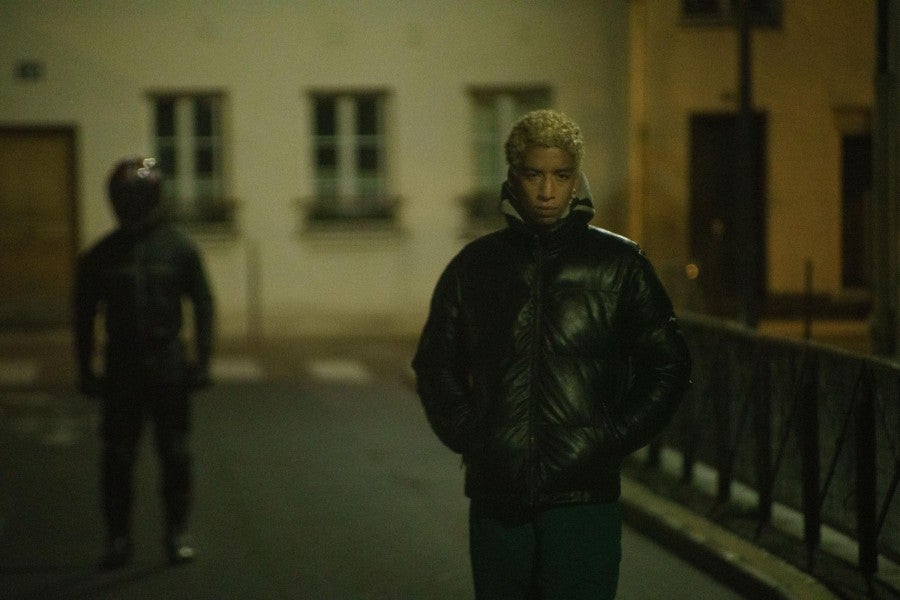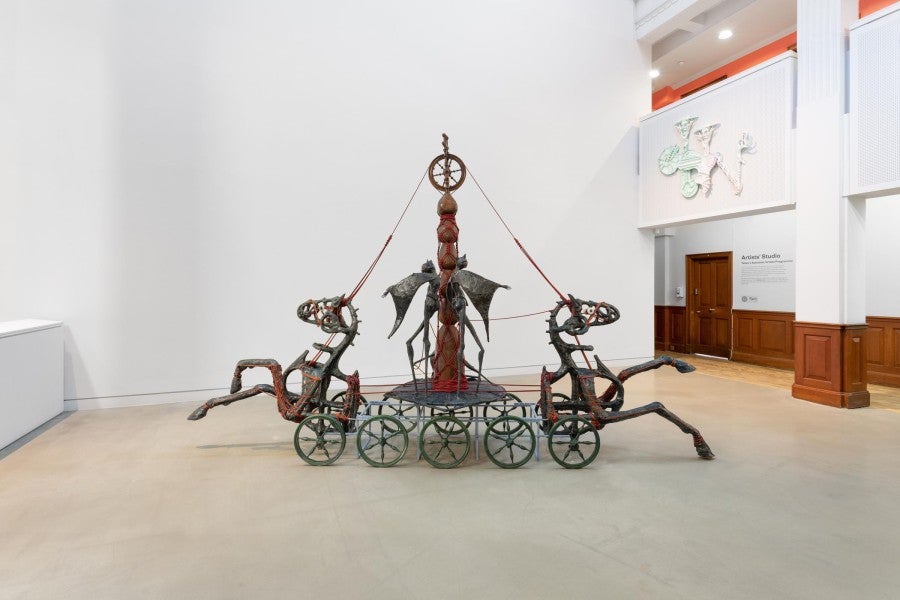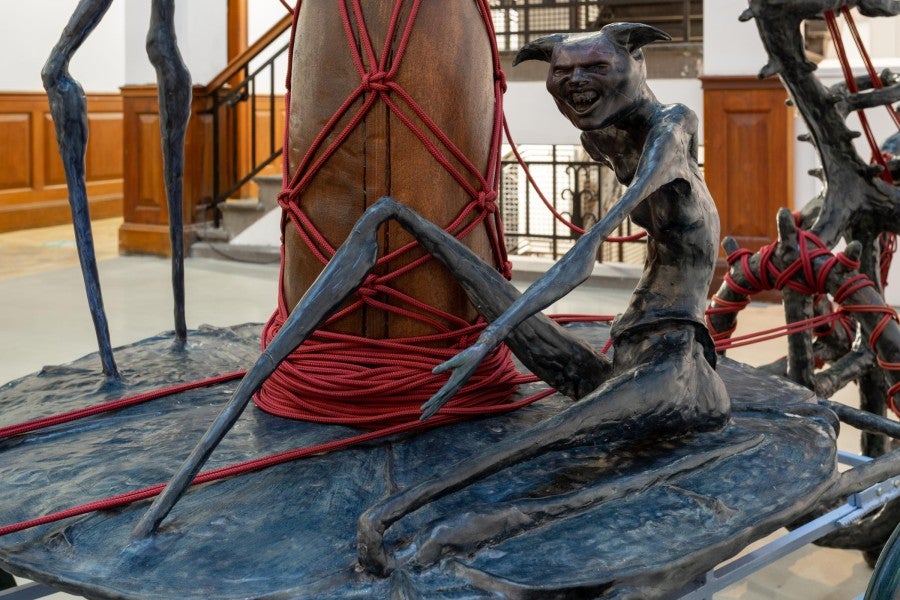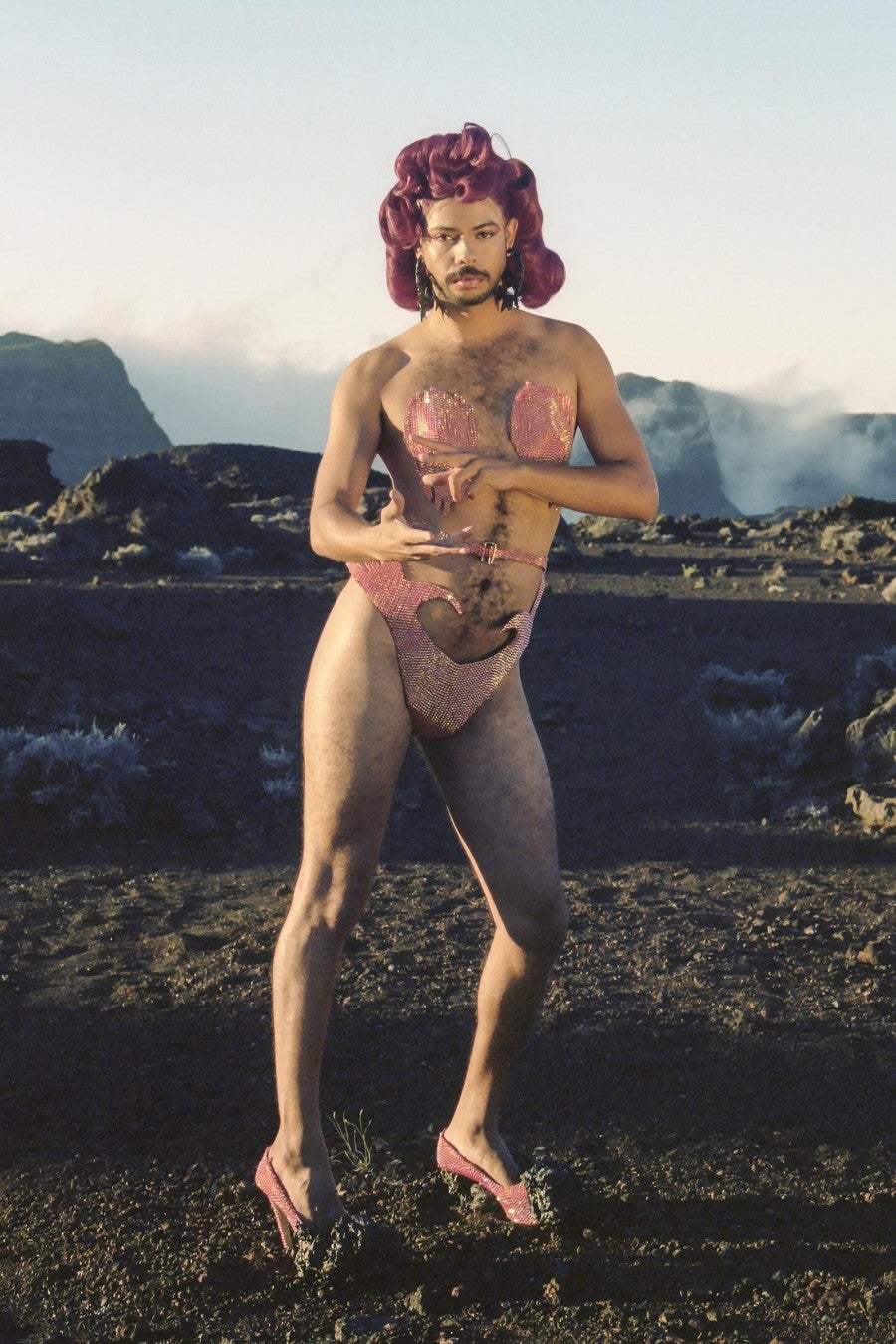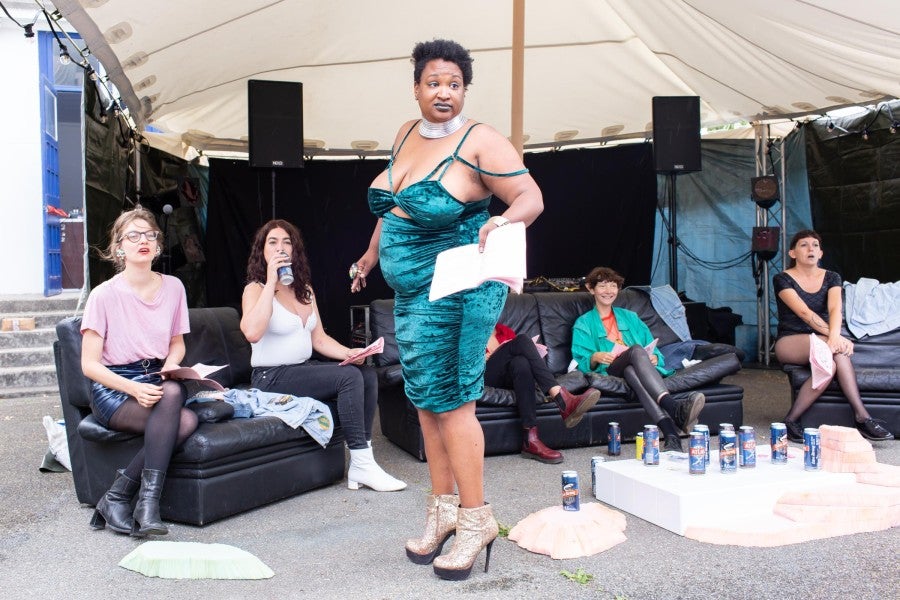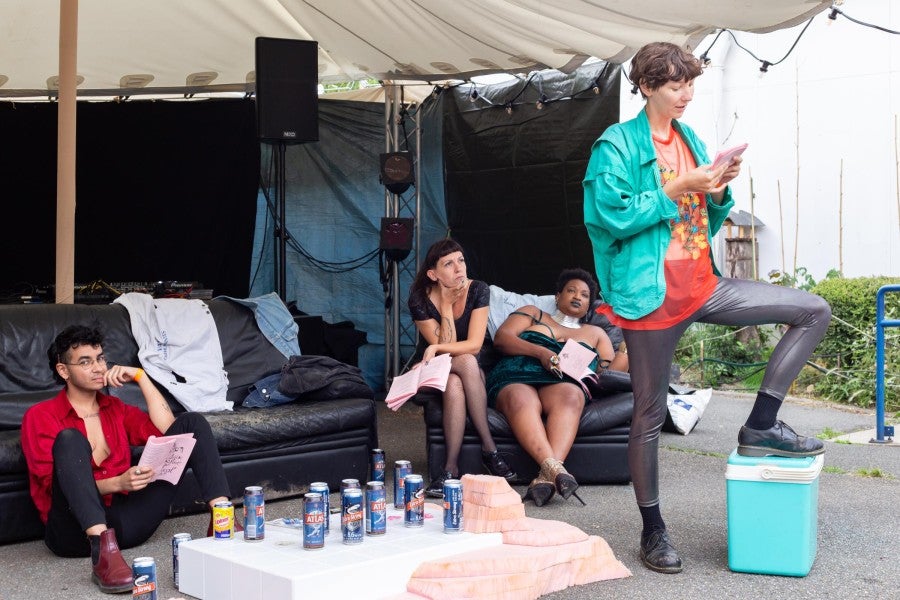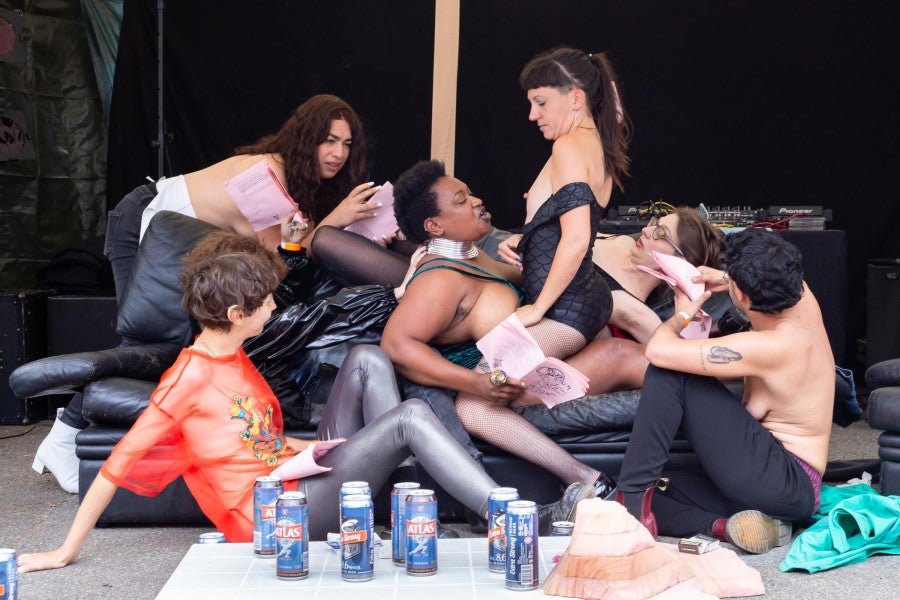Crazy / Pendulums! Queer and Chronopolitical Art Practices
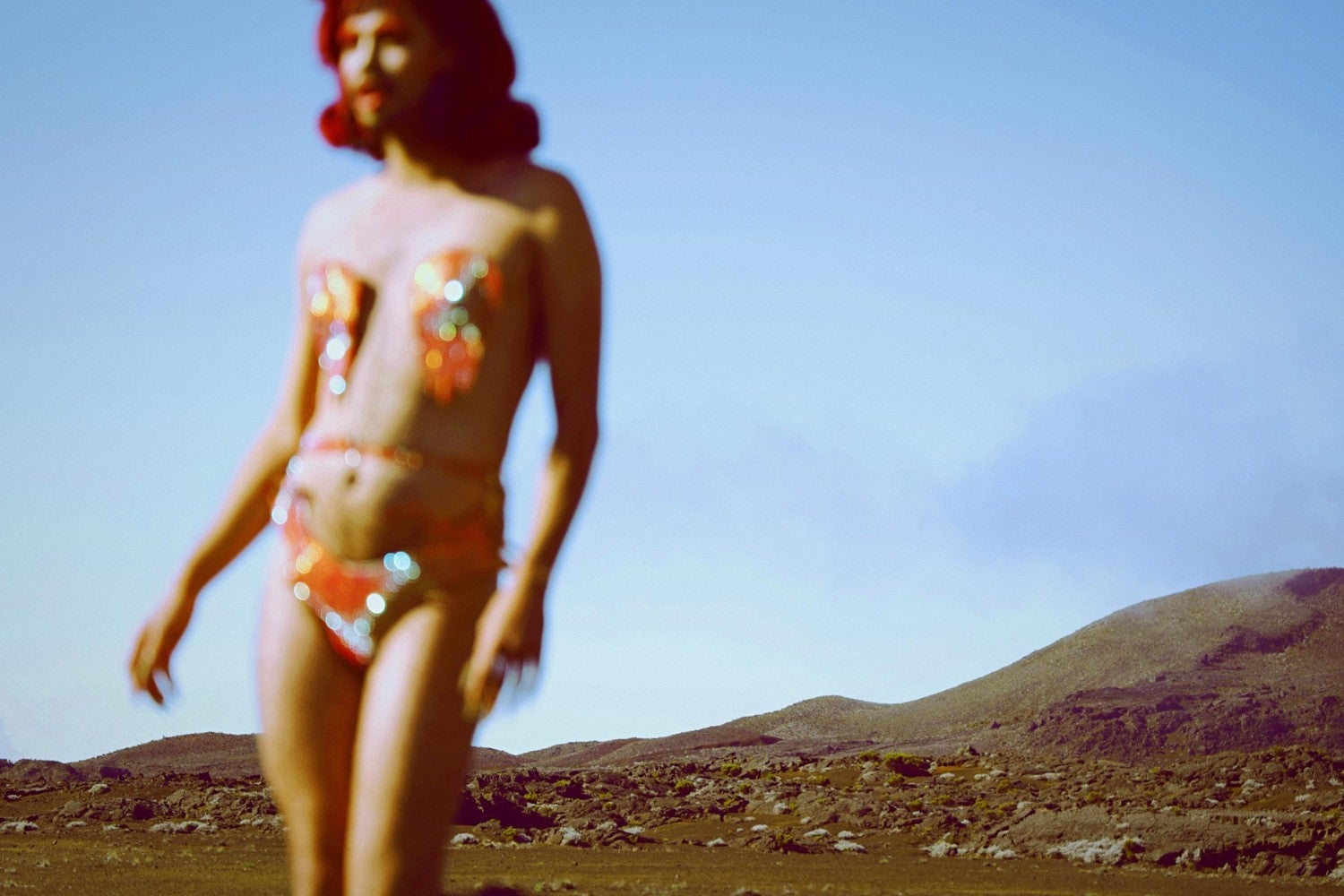
Thomas Conchou is the laureate of the first edition of the TextWork Writing Grant
When I began my curatorial residency at the Maison populaire de Montreuil in 2020, I chose to devise a series of exhibitions and events oriented towards queer art practices. I considered these practices as political propositions allowing potential futurities2 in art to be located in the present: “differences-in-form” based on which we might envisage a future that would not be the basic repetition of the past. This two-year task mobilised the staff of the art centre, around fifty artists and cultural workers, and the audience for the exhibitions, events, and festival that we built together. Through criticism, fiction, and speculation, it was a matter of collectively trafficking the systems of oppressions that hinder queer lives, but also of paying tribute to the fragility and persistence of the latter. In this space-time of work, sociability, and celebration, it was also important to me to extend my invitations to cultural practitioners who did not claim a queer identity for themselves but with whom it seemed obvious to share the tools of some of the theories and practices known as queer.
At the end of this adventure, it dawned on me that we had indeed instigated discussions among living people concerned about the future, but that we had also made room for and convoked other voices: those of the vanished, ancestors and predecessors. German artist, professor, and theorist Renate Lorenz calls these presences that persist throughout history “friends from the past” in her book, Queer Art: A Freak Theory.3 While I envisaged this curatorial experience as a way of projecting assertions into a future period (where they might no longer even need to occur) I learned through it that the past, too, comes to place demands on the present. Like a ghost, it visits us and constantly enters into conversation with us. The first exhibition from this cycle, entitled i’m from nowhere good, presented a curtain by deceased artist Bruno Pélassy4 whose spectral presence projected the phrase VIVA LA MUERTE into the exhibition space. As for the disco playlist hi-NRG that accompanied this project and gave it its name,5 it was haunted by Sylvester, Patrick Cowley, and other musicians who are no longer with us. Their lyrics, and those of many others, accompanied us and indicated new ways of engaging our understanding of time and history. It was notably a question of inheriting memories, forging historical and political lines, and understanding the various temporal regimes that we inhabit, in spite of ourselves.
For over a dozen years, queer theory and its practitioners have collectively taken hold of the vast subject of time and its many conceptual ramifications: historicity, temporality, progress, duration, perceived time, “straight” time, and “queer” time, to name just a few. According to the academic Jaclyn I. Pryor, this interest shows that the field of gender and sexuality studies has gradually distanced itself from sex and relationality theory to address broader cultural claims that find an echo and a degree of success within mainstream academic discourse.6 Within the same movement, the rereading of modern sexual taxonomies as dated historical inventions7 opened up the possibility for considering certain periods as beyond the field of influence of homo-hetero binarism – today, it has a new lease on life with the discovery of a queer Middle Ages.8
Through a critical rereading of space-times in which they locate heteronormative shifts, queer theorists turned away from a monolithic model of historicity to consider our relationships with time and with history within an affective and plural mode. In his seminal book In a Queer Time and Space, published in 2005, Jack Halberstam supports the idea whereby queer subcultures and their participants produce alternative temporalities by refusing to inscribe their lives within the temporal markers and rites of the heterosexual chain of production: childhood, marriage, reproduction, etc.9 Beyond this, he explains that because we experience time as a natural progression, the constructed character of these rhythms and habitual practices escapes us.10 Several years later, Elizabeth Freeman attacked the “orifices of history” in Time Binds: Queer Temporalities, Queer Histories, published in 2010. She offers a series of concepts enabling a notion of queer time to be expressed, such as chrononormativity (the temporal norms within which we live), chronopolitics (the various ways of engaging with, negotiating, or refusing these norms) or erotohistoriography (a sensual and incorporated way of connecting oneself to history). She seeks above all to find “non-sequential – non-teleological – forms of time [that] fold subjects into structures of belonging and duration that may be invisible to the historicist’s eye: affective registers irreducible to traditional historical research”.11
Through minority historiographic practices, new ways of reading the past and connecting with it are offered to us. Renate Lorenz12 suggests the term “queer archaeology” for a practice that aims to identify denormalising strategies (of rupture and disorder) in the past to be brought back into the present. Author and gallerist Isabelle Alfonsi invites us to construct our queer lineage to complexify the great narrative of white, heteronormative, ableist, and bourgeois history. Art historian and critic Élisabeth Lebovici shares with her readers the emotional experience of an “AIDS time”13 and the relational, artistic, professional, and amorous connections that attach the artistic creation of the 1980s to those who died in the epidemic. On the other side of the temporal spectrum, the French translation published in 2021 of the book Cruising Utopia: The Then and There of Queer Futurity by Cuban-American José Esteban Muñoz, initiated by Rosanna Puyol and translated by Alice Wambergue, makes available to a French public the radicality of a thinking entirely turned towards utopia and the future as political forces.
By questioning a heteronormative historicity whose queer individuals are systematically absent and the teleological conception of a progress-time in service to the capitalist demands of modernity, the “temporal watershed” of queer theory perpetually emulates new contributions, which this essay draws on to enter into conversation with the work of six artists. Tarek Lakhrissi, Claude Eigan, Nils Alix-Tabeling and Justin Fitzpatrick, Brandon Gercara, and Élodie Petit have taught me to densify the relationship that I maintain with my own queerness and to the one that we share. Each in their own way, through the mediums of sculpture, video, performance, and poetic writing, they work to unpack the rigid linearity of time as it presents itself to us, to consider potential alternative temporalities enabled by a queer time. Some of the artworks on which this corpus is based are in progress (working phases, projects under development, scripts or scenarios), others are completed and have already entered circulation. Whatever their status, they offer exciting perspectives as to the ways in which contemporary queer artistic productions wishing to partake in a radical shift away from the present cannot do without a criticism of the temporal conditions on which that present is built.
Queer Vampires and Industrial Time
In his latest film, currently in progress, Tarek Lakhrissi revives certain themes present in Out of the Blue, his first short film that came out of his residency at the Galerie de Noisy-le-Sec in 2019. For The Art of Losing (2022) [later titled Cœur Brillant (2023)], the initiatory quest, flight, and encounter with spiritual entities compose a nocturnal fresco that derives its visual codes from supernatural and fantasy film genres. Tarek Lakhrissi is the artisan of a greater visibility for queer and racialised people within cultural representations. Here, he convokes his chosen family, and stages a main character – Jahid – played onscreen by Dourane Fall. The introductory sequence sees Jahid leaving a friend then walking alone through a slumbering Paris. Suddenly chased by a leather-clad man with a masked face, Jahid seeks a place to hide. Around a street corner, he enters the premises of an old museum whose door is open. Wandering through the galleries, he progressively slides into a space-time suspended between dream and consciousness. He meets Opal and Kahina in one of the museum’s rooms, two benevolent vampires who read aloud a text by Kaoutar Harchi. In this examination of betrayal and shame, the author discusses her painful path towards emancipation, from guilt to the refusal of an ostracising social order that passes off its imposed hierarchies as natural.
For this story that brings into play the many threats weighing on the existence of racialised persons in France (police brutality, systemic racism, shame, and the difficulty of navigating an adverse society), the backdrop of the museum is more important than it first appears. The Art of Losing is shot at the musée des Arts et Métiers, between the galleries of communications and the desanctified chapel that conserves Léon Foucault’s pendulum with its implacable rhythm. Jahid strides through an institution entirely dedicated to sciences and technology: in other words, human progress. As he finds refuge in this place to flee a repressive and brutal threat, he discovers the history of systems of communication (telephone, fax, camera) which facilitate the condition of widespread surveillance in which we live. Furthermore, the measurement of the information – that of time – is omnipresent. The heavy sound of a clock can be heard.
In On the Concept of History, Walter Benjamin virulently criticised this “storm that we call progress”.14 The continuum of history, caught in the progression of an automatic linear time, travels towards ineluctable, unlimited progress that is impossible to avoid. While Benjamin reminds us that historically articulating the past means becoming the master of a memory, the conception of a future undistinguished from technical progress and the mastery of nature impose themselves as the natural horizon of humanity, by subjugating workers and ecosystems to its forced pace. In this temple to the glory of industry, Jahid confronts not just the habitual violence that informs his everyday life, but the historicity of the conditions that have led to the construction of the major narratives of modernity that our present has inherited.
The industrial revolution is inseparable from the colonial project, and the same goes for a certain conception of progress-time. Rahul Rao, in his book Out of Time: The Queer Politics of Postcoloniality,15 returns to the cartography of time in the space imagined by Hegel, who sees Africa as the past of Europe and Europe as the future of humanity. The justification of the process of subjugation and expropriation of the colonial conquest propels its debt onwards: primitives, one day civilised, might finally think of themselves as human. This constitution of the primitive as a being imprisoned in the past is historically contingent on that of the deviant or pervert.16 During the same period, sexology, psychoanalysis, and anthropology produced categories of radical difference that described inhibited individuals with retarded development. People who cause the flow of time to falter, by emphasising their lateness or regression. In the work of Tarek Lakhrissi, the figure of the déviantx, as he calls it, builds a bridge between these two historical categories, so as to better transform them into emancipatory narratives.
Kahina and Opal, the two vampires of The Art of Losing, represent this hitch in the progression of time. Vampires are precisely an historical fixation point that interconnects time and perversity: immortal, immutable, they revel in the pleasure and satisfaction of their desires without suffering or fearing the inexorable character of the future. Represented as messengers of personal and decolonial emancipation, they appear to Jahid to warn him and deliver a message of hope to him: “Outside, the world is transforming. I hear the Old Europe trembling.” Once “initiated” by this esoteric intervention, Jahid is once again visited by a presence: that of a man swaying languidly to electronic music. In tribute to the work "Untitled" (Go-Go Dancing Platform) by Felix Gonzalez-Torres, produced in 1991, his character appears bare-chested, but wears a dinosaur mask. Half-human, half-reptile, he seduces Jahid, who envelopes him in a movement of acceptance of his own strangeness – synonym of his queer identity and desires. As he leaves the museum, Jahid is assaulted by the leather-clad man. He discovers that he has powers that are reminiscent of those of Kahina and Opal. As they leave, they promise to be present by his side, wherever he goes, always.
The Art of Losing can be said to stem from a queer chronopolitics because the film and its characters weaken the idea of a “natural” linear progression of time, in favour of a queer persistence throughout history. Déviantx bodies have always represented a spanner in the works of modernity and its mechanical distribution of the privileges of human rights, including the ability to occupy or invest the past, present, or future. Here the revelation of the queer experience through the presence of vampiric immortals brings a form of spectrality into play, or haunting, through which a trans-historical desire requires that the present acknowledge its full and complete existence. Cited by Rahul Rao, historian Nayan Shah warns against the dangers of wanting to produce a historicity to sanction queer existences and defends the fact that in reality they exist here and now.17 Only in this reality should they be considered, respected and defended. The Art of Losing does not seek to come under this affirmation within the historical time of progress, but instead to position itself in defence of queer and racialised lives.
Touch the Past through “Texxture”
For his first monographic exhibition in France in June 2021, Claude Eigan presented the project dandelion menace at the Galerie Artemis Fontana and a series of sculptures paying homage to plant families. Starting with Taraxacum, commonly known as dandelion for its diuretic abilities but also for its pointy leaves and fluffy yellow ruff. It inspired mural sculptures in the form of jaws ready to bite, that held GPS coordinates of historical sites of queer sociability in Berlin and San Francisco, or traditional slogans from LGBTQIA+ communities. Two other ensembles of artworks, bouquets of fists (Soft and Stone and High, 2020) and corolla-shields (under no king, 2021), transformed the gallery space into an oversized herbarium in which each plant proved to be spiky and surly. Just like the stele of the Hammurabi Code dedicated to the law of Talion (an eye for an eye, a tooth for a tooth) in Babylon, the works of Claude Eigan appropriated the renowned Bash Back! of the Pink Panthers Patrol and claimed rage as a political space. Formally, they approached the idea of the threat, violence, and retribution based on a minority position. These flowers of resilience embodied a garden of self-defence in which the dialectic between the representation of violence and violent action were offered as two sides of a labrys: the double-sided axe used by the Minoan civilisation as a religious symbol. Historically associated with the Amazons, it was adopted in the 1970s by lesbian feminist movements.
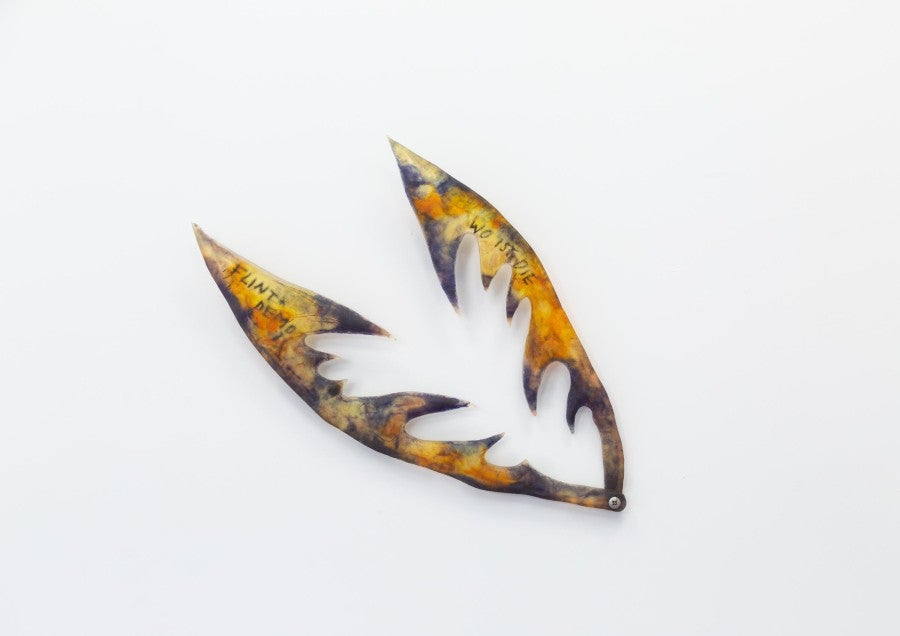
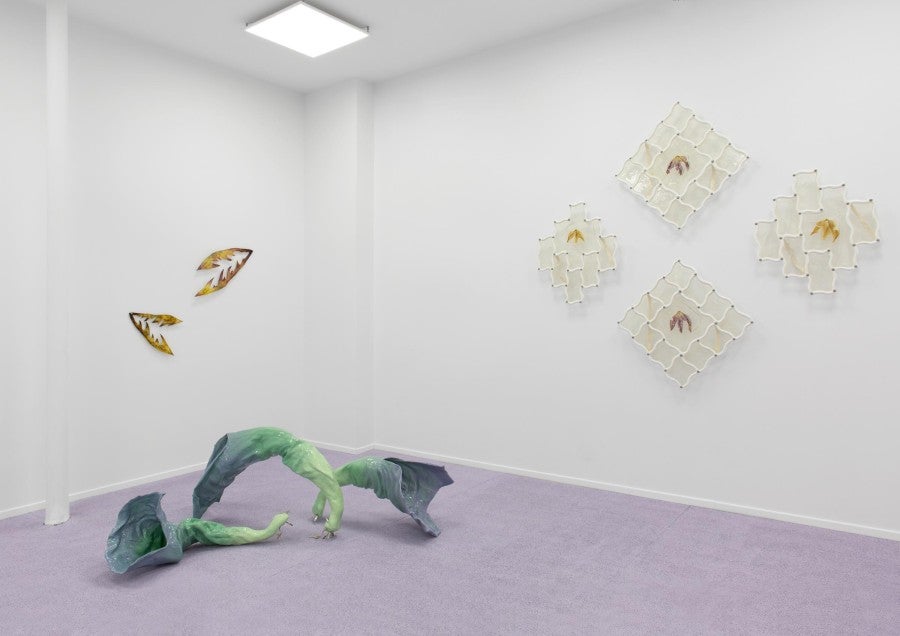
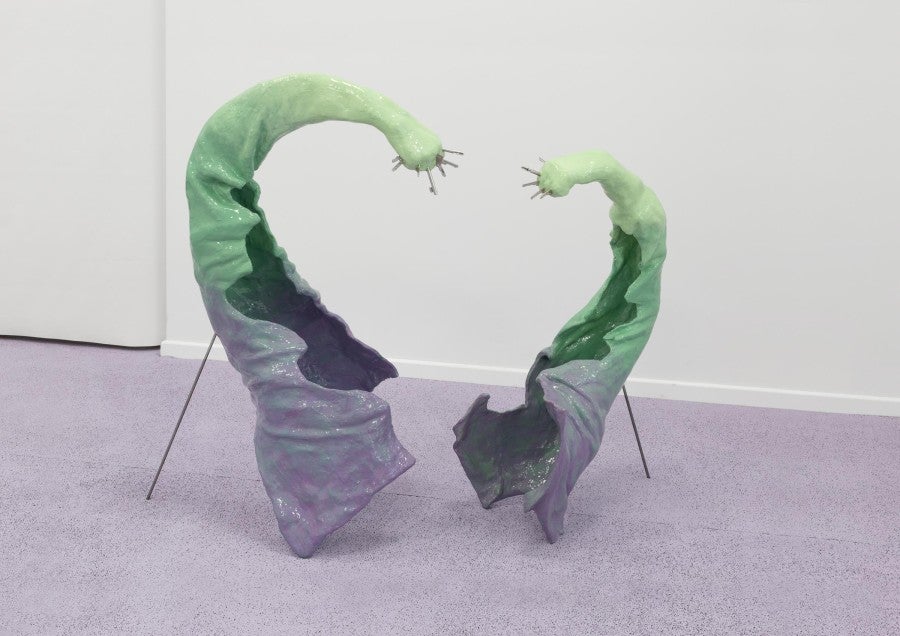
The series Soft and Stone and High represented vegetal horns of plenty. At first seeming lasciviously deposited on the floor, they ended in fists armed with keys, caught in the tension of an eventual attack. For this series of sculptures, the artist called on his friends, formulating their attitudes of defence when they went home alone at night or in an environment that didn’t seem to guarantee their safety. Claude Eigan’s fist bouquets recall the long tradition of struggle and self-defence within queer communities and the history of feminism. They are inspired by movements such as Queer Nation (founded in 1990 in New York and the origins of the famous slogan We’re Here. We’re Queer. Get Used to It) or the Pink Panthers Patrol (unarmed queer pedestrian patrols equipped with whistles and uniforms, also initiated in the early 1990s) which aimed to form counter-threats outside of the enclaves of LGBTQIA+ neighbourhoods and invaded heterosexual sites of sociability by going out in the street as groups. These collectives aimed to attack the privileges of normalcy by re-territorialising the spaces of danger and violence for queer bodies, while producing images of radical otherness to diminish the hegemony of the heteropatriarchal system of violence.
In an article entitled “Outing Texture” published in 1997 under the direction of Eve Kosofsky Sedgwick, the author Renu Bora expressed the way in which texture is intimately related to temporality. Its first definition signifying the surface of resonance or the quality of an object, the texture of a material consists in its ability to respond to contact through sensation, or to dispose of certain material properties that can be anticipated by the gaze. Hence touch, physical pressure, sometimes simply a glance transform our perception and anticipate the desire (or lack thereof) to experience, sense, or appreciate this or that object. As for temporality, it is intrinsic to the meaning of materiality, since time informs the texture of materials and we experience them through it. Once this first definition is established, Renu Bora proposes a neologism to complexify the concept of texture: texxture. This would not so much refer to the surface of the materials as to an experiential, intermediary, more phenomenological than conceptual level, and perceived as the capacity for resistance and response to material. Texxture complicates an object and directly appeals to its narrative and temporal dimension, suggesting a surplus of perceptible information in an intimately violent way. The physical experience of food consumption, the intensity of sexual sensation in the relationship to the other or to an object form two hedonistic domains of texxture that enable us to connect with sensations over time.
It seems to me that the texxture of the artworks of Claude Eigan’s series Soft and Stone and High is immediately perceptible. By representing gestures frozen in self-defence and violence, Claude Eigan propagates a powerful affectivity that inhabits all minority bodies: the constantly suspended question of our bodily safety, the permanent threat that our existence within public space poses to our physical integrity. In addition, by placing temporal identifiers all around the exhibition space in the form of “jaw-leaves” from the series Pissed, the artist reminds us that the history of struggles of our communities is a long litany of violence, losses, and deaths. For theorist Carolyn Dinshaw, the question of queer historiography amounts to being able to “touch time”.18 Here, we connect ourselves to time through rage and grief, through gestures of physical confrontation whose materiality recalls a common history, lived or experienced, and whose urgency continually resurfaces in the present.
Ideo-Motor Pleasure
Nils Alix-Tabeling and Justin Fitzpatrick are sculptors, and also a dramatist for the former, painter for the latter. They maintain a sustained conversation regarding their respective subjects of study and work, helping one another in their mutual practices and sometimes collaborating on shared artworks. As part of Nuit Blanche 2021 at the Maison populaire de Montreuil, they collaborated on the production of a sculpture entitled Moteur idéal inspired by works on time and duration by philosopher Henri Bergson. In Matter and Memory, published in 1896, Bergson developed a philosophy of the body captured in its relationship to the mind, to perception and memory. For the artists, the incorporated/perceived experience and the reflexive/interior experience describe two polarities that inform our experience of time and that are each embodied in an element of their installation. Either side of the central structure, borrowing its form from parade chariots and itinerant theatre sets, two rearing horses are represented. Named “the nervous system”, they embody the corporeal dimension of our relationship to experience and to the present, in all its vivacity. Without memory capacity, they are caught in the violent immediacy of pure perception, and attempt to lead the chariot in the direction of the slightest stimuli affecting them. They inhabit an atemporal reality in which they are caught on the spot, almost dazed by the sensational power of reality. Each situation appears to them as new and terrifying: they act without knowledge. For the artists, they represent tension, action, and reflex.
In the form of coachmen, three figures were inspired by the famous illustration by Urs Amann for Klaus Schulz’s Timewind album (1974). They dance and laze about on a flower with five petals. These pussycats represent reflexive time: the one that we figure, that we anticipate, and that we recall. Reminiscent of the three Fates, they create a composition in macramé that evokes the canvas of time. All entirely absorbed by their tasks, wrapped up in themselves in an introspection blind to the outside world, they represent pure memory, disconnected from the physicality of the world. They know, but cannot act, because since they are left to their own devices, the immensity of the choices and of past events or those yet to come plunges them into an anxious paralysis.
It is in their relationship to the horses, their mastery of the perceptual force of the nervous system that they attempt to order the information and stimuli that frighten the latter. They come to interconnect senses and memory, perceived time and figurative time, enabling this disparate assemblage to come together to highlight the way in which the body informs subjective experience and awareness, and vice-versa. Here the body and mind are not considered in opposition but in a tight dialectic combining reflex and reflection.
For Nils Alix-Tabeling and Justin Fitzpatrick, Moteur idéal highlights the interdependencies that connect memory, experience, and conscience. But the installation also touches on a sensual dimension of corporeal experience, by assigning to each of its units a polarity of activity (the horses) and passivity (the pussycats) that recalls the one that informs certain gay sexualities. As for the column at the centre of the installation, it is inspired by different forms of sex toys such as the strings of balls used for penetration. In this formal research into the various constitutive ways of “being-in-time”, the erotic dimension of understanding the body permeates the installation, reminding us that intimacy and pleasure are constructed practices of a knowledge system that takes the body as instrument.
Accompanying the installation, a performance of the same name in the form of a two-act operetta, performed by Louis Sé, brought two mythical characters into play. On the one hand, a sundial, in love with the Sun, declaiming its flame and the burning of its erotic passions for the star, without which it could not measure time. On the other, Death, taking the form of a cosmic void or a black hole ready to digest the Universe, harassing humanity by promising its end in an act of sensual consumption. Here, the passage of time and its ancient measuring techniques were taken in an erotic relationship to the Sun and in the furtiveness of an existence of passion, while the void of space and the infinite time of the creation of the Universe embody an image of death. In a similar manner, in Shakespeare, Hamlet declares that “time is out of joint” after a visit from the ghost of his father. In this metaphor, time itself has a skeleton-body that is dislocated when the past returns to haunt the present.
Among the theorists that insist on the temporal dimension of pleasure, Elizabeth Freeman works particularly in defence of an erotic method of reading time, in her book Time Binds. She reminds us that bodily sensations are intimately linked to our historical awareness and to our memory, and that a queer erotohistoriography could pay tribute to the way in which queer relationalities always-already exceed the present. Historicity appears to her as a tactile and affective structure. In Moteur idéal, sensuality and eroticism top off the dialectic between perceptive experience and introspective experience: by connecting sense and memory, present and history, sexual practices that traverse queer cultures also enable us to envisage ways of connecting us that don’t yet exist, so to speak.
Playback & Kwir Kréol
For several years now, Brandon Gercara has developed a lip sync practice borrowed from drag shows. In his filmed performances, they replay critical theory discourses by racialised women researchers who work at the crossroads of postcolonial, feminist, and queer studies. This practice is accompanied by “impersonation” work in which the camp element becomes the resemblance with a public figure – whose apparitions do not involve stage outfits or special costumes, but a distinctive way of dressing or appearing. By borrowing voices, postures, and looks from famous female authors, Brandon Gercara produces a form of political drag that brings the work of theory into play. In the work Lip sync de la pensée (2020), the artist appears on a cabaret stage installed by the ocean, on Réunion Island, where they come from and live. Composed of the discourse of Asma Lamrabet, Françoise Vergès, and Elsa Dorlin, the film sees the artist travel comfortably from one voice to the other, one posture to the other, while producing a lip sync that finds powerful interventions from the said authors, on coloniality, gender, Islamophobia, and systemic oppressions.
For their new work Le Playback de la pensée kwir (2022), the artist and activist becomes the organic speaker of their work. Comprising an installation, a text read aloud, a costume and a photograph from the series Majik Kwir (2021) created in collaboration with visual artist Ugo Woatzi, the activation of the work subsequently gives rise to a film, shot on the heights of the Piton de la Fournaise volcano. There, Brandon Gercara recites a text written for the first edition of the Réunion Island’s LGBTQIA+ Pride March, which they initiated in May 2021. In this poignant discourse, they address the Creoles of Réunion Island and draw together the great diversity of Reunionese cultural origins and the multitude of queer identities. Reunionese hybridity, at once an historical reality and a political marketing argument concealing the huge economic and social disparities that afflict the island, becomes one of the constitutive elements of a kwir créolité.
In its filmed version, Le Playback de la pensée kwir presents Brandon Gercara standing on a stage covered with red strass and decorated with lava flows, declaiming their text. This time, the artist wears a full costume comprising a cape created by designer Ismael Moussadjee, a bikini reproducing the same strass as on the stage, a wig in deep red and fake nails adorned with olivine crystals, which are extracted from basalt flows. On their boots, pieces of cold lava have built up. By setting up on the summit of the volcano, an eternal and sacred presence of Réunion Island, they are sourcing from the images of lava and fire the power of the Piton and its eruptions. In addition, like an inhabitant of a lunar landscape, streaked with lava flows and smoke, the artist inscribes their body and affirmations within the immensity of geological time. Unpredictable and relentless, the explosions of the volcano impose their own tempo on the residents of the island. Unlike a clock, the volcano does not calculate or rationalise anything but devastates everything and reminds the island residents of their co-presence with an ecosystem marked by volcanic activity. In binding the affirmation of a Creole “queerness” with the manifestations of the volcano, its magnificent flows and capacity for destruction-creation, Brandon Gercara links the presence of queer individuals in Réunion Island with the history of the land. Their text expresses it with determination:
We reshape our territory with our own lava.
A new skin, a ground that’s still hot.
We make room for ourselves.
We burn to hybridize with our rock.
We paint the sky in the colours of fire.We are La Réunion, the earth,
Waterfalls in the cyclone season,
The blood of the volcano that hurtles against the sea’s wavesWe are kwir kréol.
Coming under the irrevocability of geological time and by expressing Reunionese cultural diversity and gender identity through the same terms, Brandon Gercara demands a historical understanding of queer existences. His text therefore broaches the shared heritage of the island’s colonial past, from slavery and plantations, and draws a parallel between the eclipsed history of slave lives and those of queer lives. In Out of Time: The Queer Politics of Postcoloniality, published in 2020, Rahul Rao deals with the haunting quality of memory, including “the constellation of connections that charge the present time with the debts of the past”.19 For Kora Keeling, in the book Queer Times, Black Futures, published in 2019, “queer vestiges” are generative and de-territorialising forces20 allowing a future to be built that clashes with the present. The queer Creoles of Brandon Gercara’s work bear the heritage of slavery, coloniality, and silenced history; yet they derive from these connections through time the strength to assert their own emancipation in the present.
Drama Queens on Fire at the Banquet
BAISE SALIVE BAISE ALCOOL BAISE, une réécriture possible du Banquet de Platon [FUCK SALIVA FUCK ALCOHOL FUCK: A Potential Rewriting of Plato’s Banquet] is a piece of theatre devised by Élodie Petit in 2021. In it, she narrates a crazy evening among homosexual poetesses brought together at the home of the young and talented Agathon. Socrates, Pausanias, Aristophanes, Eryximachus, and Phaedra are invited to celebrate her talents, while Alcibiades, outcast and jealous, forcibly invites herself. Between two cans of beer accompanied by humus toast, the poetesses talk about amoure with an “e”: the kind that they feel for their lovers, for their political commitments, for the substances they consume immoderately, and for their passions for the erotic pleasures of the flesh. The evening advances and with it the inebriation of the guests, who are becoming increasingly drunk and lustful. The poetic declarations in honour of Eros make way for a wild carnal consumption, between confidences. Anxiety, dependency, lesbian love, and precarity paint this erotic fresco of nostalgia and flamboyance.
Most of the characters in Banquet find themselves represented in BAISE SALIVE BAISE ALCOOL BAISE, except for Aristodeme, a disciple of Socrates’, and Diotima, a prophetess whose word was reported by Socrates since her status as a woman did not authorise her to be present. Élodie Petit also conserves the social status and age indications of the characters: Eryximachus is a doctor, Phaedra is young and brilliant. Yet all the attributes of privilege such as masculine gender, the wealth and prestige of the family that fuels the dynamics of Plato’s Banquet are absent from this feminist and impoverished reinterpretation. Élodie Petit’s poetesses live at the margins, drink from beer cans from major supermarket chains, and consume ecstasy pills for €10 a pop. They recite poems to amoure against capital, and don’t concern themselves with social success and material comfort. Only the pleasures of the senses – which they explore ingeniously and rapaciously – matter to them. In this little community through which we perceive powerful relationships of love and friendship, the assemblages of desire and its consumption play a central role in interpersonal dynamics. Dictated by their complete devotion to Eros, the poetesses quench their erotic thirsts and gauge behaviour types among themselves in a single movement, without one being subordinate to the other.
This libertine vision of attachments and desire is found in the writings of Jaclyn I. Pryor when she declares: “Indeed, queer and trans people have always been at the vanguard of radical ways of working, playing, fucking, organizing, educating, parenting, making home, making art, and creating ritual that defy normative patterns of clock, biological, and nuclear family time.”21 Élodie Petit’s poetesses embody images of relational radicality and facetiously reinterpret a monument of classical literature. These seven incarnations stem from what Renate Lorenz calls transtemporal drag:22 a performance that activates phenomena of historical copresence on the bodies of the performers. This practice of relationship to history permits experimentation, in the present, with the processes of construction of emotions, affects, and desires from the past. By replaying the scenes of discourse and displacement of “musical chairs” from the original Banquet, while drawing out the scene into the early morning hours, Élodie Petit allows her actors to physically represent the modes of experience described by Plato. The incarnation of the characters enables images from the past to be experimented on and experienced, in service to alternative conceptions of pleasure and relations.
Crazy / Pendulums!
As Elizabeth Freeman explains in the collective book edited by Renate Lorenz and entitled Not now! Now! Chronopolitics, Art & Research, the exclamation point is a composite/folded character based on the Latin io, a cry for joy. The “i” was gradually placed above the “o”, which became a dot, transforming the word into a sign. This fold marks, in her opinion, the expression of powerful feelings, of structures of emotions and affects, “a power rather than a figure and way of ‘being-in-time’.”23
As for the Bædan collective, in its Journal of Queer Time Travel it is interested in the slash used by Samuel R. Delany in his text Coming/Out24 to trip us up on the new meaning of the expression “to come out of the closet” which was disseminated in post-Stonewall mainstream culture. While “coming out” referred to the idea of undertaking one’s first homosexual experience and entering into the queer half-world of the time, the expression was later transformed to mean “exposing oneself to heterosexual society”. For Delany, this marks the violent capture of an idiom that up until then was reserved for LGBTQIA+ communities. By placing a slash between the two words, Delany sabotages their sequence and produces a delay in their reading, in the form of a hesitation or double take. The sign marks his desire for resistance to the semantic shift of a marker from its community history.
In her treatise on the “temporal turn” in contemporary art,25 Christine Ross affirms that contemporary art broke away from the modern conception whereby the fine arts, in opposition with literature or poetry, was not able to represent the passage of time, but only to “capture” the moment. By developing through a diversity of mediums (performance, installation, photography, film) that render the notions of appearance, duration, and contingency of the action tangible, contemporary art multiplies its relationships to time and reconfigures the relationships between audience, artwork, and artist through temporality. The unrecognised time of modernity (that of women, for instance)26 is represented and defended within it, to lead an attack against linear time and its productivist imperatives. The passage of time, she tells us, is reformulated to take into account “contemporary experiences of temporal passing moulded by unproductiveness, fissuration, extendibility, ruination, equalization, unframability, and interminability”.27
The search for trans-temporal emotional structures and the desire to interrupt (or cause to stumble) the linear flow of teleological time emerge as the two polarities of contemporary queer chronopolitics. They are expressed in the works of the artists studied here through suspensions, prolongations, repetitions, compressions, interruptions, ellipses, flashbacks, and anticipations. Tarek Lakhrissi, Claude Eigan, Nils Alix-Tabeling and Justin Fitzpatrick, Brandon Gercara, and Élodie Petit strive to scrutinise the productive time of capitalism, the progressive-time of the colonial project and the heteronormative time of the patriarchal system, to find folds, crevices, and loops within it, in which to produce new political horizons based on their artistic practices.
Translated from French by Anna Knight
Walter Benjamin, “Theses On The Philosophy Of History”, in Illuminations, ed. Hannah Arendt, trans. Harry Zohn (New York: Schocken Books, 1969), 261–262.
José Esteban Munoz, Cruising Utopia: The Then and There of Queer Futurity (New York: New York University Press, 2009).
See the preface of Renate Lorenz’s book, Queer Art: A Freak Theory (Bielefeld: Transcript Publishing, 2012), 9. Accessed online: https://www.transcript-publishing.com/media/pdf/9a/5e/2a/ts1685_1JaY0eWiLe02uc.pdf
Born in Laos in 1966, Bruno Pélassy was a self-taught French artist who died of AIDS at the age of 36, in Nice.
no no desire desire, can be heard here: https://open.spotify.com/playlist/2i2MPWnh4X2Hwnd1qexYTP?si=nHB-CXy1ScafiLHTq96dNA&nd=1
Jaclyn I. Pryor, Time Slips: Queer Temporalities, Contemporary Performance, and the Hole of History (Evanston: Northwestern University Press, 2017).
Michel Foucault, The History of Sexuality - The Will to Knowledge, trans. Robert Hurley (Paris: Éditions Gallimard, 1978).
Clovis Maillet, Les genres fluides : de Jeanne d'Arc aux saintes trans (Paris: Arkhé, 2020) and Bill Burgwinkle, Queer Theory and the Middle Ages, in French Studies, vol. LX, no. 1, (January 2006).
Jack Halberstam, In a Queer Time and Place, Transgender Bodies, Subcultural Lives (New York: NYU Press, 2005).
Inspired by the work of David Harvey, The Condition of Postmodernity: An Enquiry into the Origins of Cultural Change (Cambridge, Oxford: Wiley-Blackwell, 1991).
Elizabeth Freeman, Time Binds: Queer Temporalities, Queer Histories, (Durham: Duke University Press, 2010), 11.
Lorenz, Queer Art, 124. The concept is borrowed from Matthias Haase who outlines the notion in “Histories that are Written in the Night” in Golden Years, Materialien und Positionen zu Queerer Subkultur und Avantgarde zwischen 1959 und 1974 (Graz: Edition Camera Austria, 2006), 173–183.
Élisabeth Lebovici, Ce que le sida m’a fait. Art et activisme à la fin du XXe siècle (Zurich: JRP Ringier; Paris: La Maison rouge, 2017), 39, borrowed from William Haver in The Body of This Death (Stanford: The Stanford University Press, 1996).
Walter Benjamin, “On the Concept of History” (1940) in Illuminations, ed. Hannah Arendt, trans. Harry Zohn (New York: Harcourt, Brace & World ,1968). Consulted online at the Brooklyn Institute for Social Research.
Rahul Rao, Out of Time: The Queer Politics of Postcoloniality (New York: OUP USA, 2020).
Rao, Out of Time, 1. Borrowed from Neville Hoad, “Arrested Development or the Queerness of Savages: Resisting Evolutionary Narratives of Difference” in Postcolonial Studies, vol. 3, no. 2 (2000): 133–158.
Rao, Out of Time, 24. See “Sexuality, Identity, and the Uses of History” in A Lotus of Another Color: an Unfolding of the South Asian Gay and Lesbian Experience, ed. Rakesh Ratti (Boston: Alyson Publications, 1993), 113–132.
Carolyn Dinshaw, Getting Medieval, Sexualities and Communities, Pre- and Postmodern (Durham: Duke University Press, 1999).
Rao, Out of Time, 23.
Kora Keeling, Queer Times, Black Futures (New York: New York University Press, 2019), 16.
Pryor, Time Slips, 5.
Lorenz, Queer Art, n.p.
Renate Lorenz, ed., Not Now! Now! – Chronopolitics, Art & Research (London: Sternberg Press, 2015), 13.
Bædan: Journal of Queer Time Travel, Bædan, 2015, 18. Accessed online: https://baedan.noblogs.org/
Christine Ross, The Past is the Present; It’s the Future Too. The Temporal Turn in Contemporary Art (London / New York: Continuum International Publishing Group, 2012).
Such as Semiotics of the Kitchen (1975) by Martha Rosler, or Slave Days by Pati Hill, from the same year.
Ross, The Past, 5.
